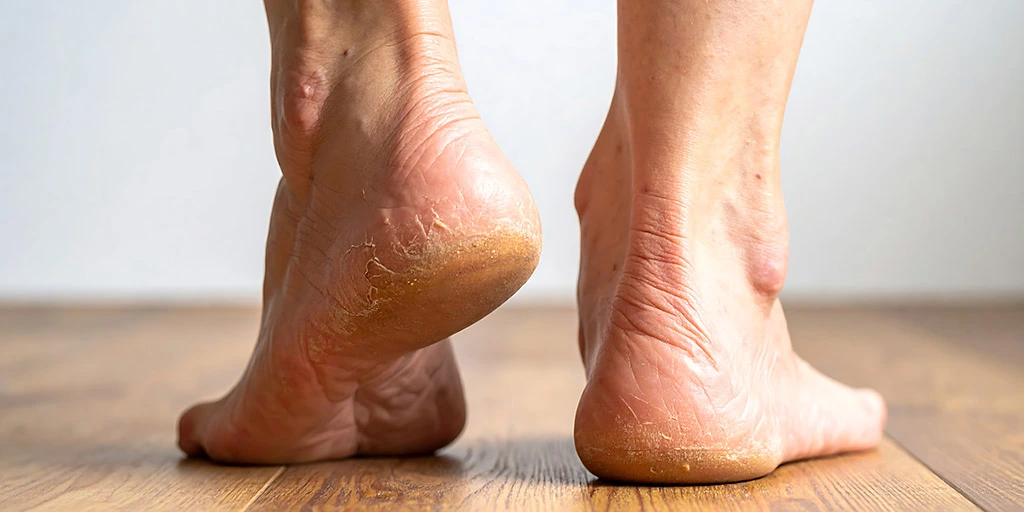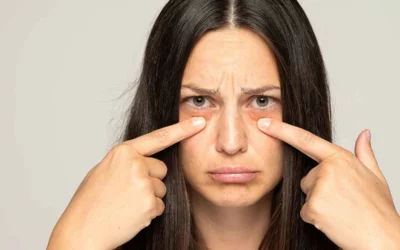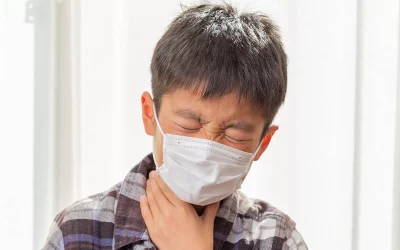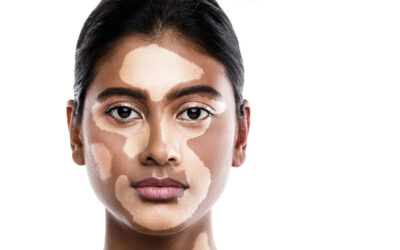Dry Skin to Cracked Heels: Winter Skincare Tips That Work

Winter can be harsh on the skin, leaving it dry, itchy, and more sensitive than usual. As temperatures drop and humidity levels fall, the skin loses moisture much faster, leading to tightness, flakiness, and in many cases, painful cracked heels. These concerns often begin mildly but can quickly progress when left unaddressed, affecting both comfort and daily routines. To help ensure this doesn’t happen to you, this article explains why winter dryness occurs, the symptoms to watch for, effective ways to care for your skin and heels, and when certain signs may need medical attention. Let us begin by understanding the basics.
Table of Contents
ToggleWhat Causes Dry Skin and Cracked Heels in Winter?
Dry skin and cracked heels become more common in winter because the cold, dry air pulls moisture out of the skin much faster than usual. When temperatures drop, humidity levels fall, and the skin loses the natural oils that normally keep it soft and protected. As a result, the outer layer of the skin becomes rough, tight, and less able to hold on to moisture.
Indoor heating also plays a major role. Room heaters reduce moisture in the air even further, making the skin drier. Hot showers, which feel comforting in winter, strip away protective oils from the skin and worsen dryness.
Over time, the skin on the heels becomes thick, stiff, and less flexible, causing small cracks that can deepen and become painful. Certain factors make some people more likely to develop cracked heels, such as standing for long hours, wearing open-back footwear, having dry skin conditions, or being overweight, which increases pressure on the heel.
Read More: Dry Skin in Winter? Here’s Why It Happens and How to Treat It
Signs You May Be Developing Winter Dry Skin and Cracked Heels
Winter affects the skin in a number of ways, and early changes are often subtle. Recognising these signs helps prevent dryness from worsening or leading to painful cracks. Common indicators include:
- Tight or stretched feeling on the skin
- Flaky, rough, or dull-looking Fpatches
- Itching or increased skin sensitivity
- Thickened, hard skin around the heels
- Fine lines that gradually turn into deeper cracks
- Discomfort or pain while walking
- Redness or mild swelling near cracked areas
Winter Skincare Tips That Work
Winter dryness can take a toll on both the skin and feet, but a few practical habits can make a noticeable difference in keeping them soft, comfortable, and healthy. The focus during this season should be on locking in moisture, protecting the skin barrier, and preventing early signs of dryness from progressing into painful cracks. The following tried-and-tested tips help support skin health throughout the colder months:
Moisturise at the Right Time
Applying a rich moisturiser immediately after bathing helps trap moisture and create a protective layer on the skin. Night-time application offers deeper hydration and supports natural repair.
Switch to Gentle Cleansers
Mild, soap-free, or cream-based cleansers clean the skin without stripping away natural oils, helping maintain smoothness and reducing irritation.
Avoid Long, Hot Showers
Warm showers are kinder to the skin and help prevent the dryness that often follows prolonged exposure to hot water.
Use a Humidifier Indoors
A humidifier adds moisture back into indoor air, helping prevent tightness, itching, and dryness caused by room heaters.
Stay Hydrated Throughout the Day
Even in winter, regular water intake supports overall skin health and prevents dehydration-related dryness.
Protect Exposed Skin from Cold Winds
Covering the hands, feet, and face when stepping outdoors helps reduce irritation and moisture loss caused by cold winds.
Exfoliate Gently and Regularly
Gentle exfoliation once or twice a week removes dead skin buildup and helps moisturisers absorb more effectively.
Care for Your Heels Daily
Using a heel balm or thick cream softens the skin and prevents small cracks from turning into deep, painful fissures.
Caring for Cracked Heels in Winter
Cracked heels tend to worsen during winter due to reduced flexibility and moisture in the heel skin. Once cracks form, they can deepen quickly, causing discomfort and difficulty while walking. Proper care at the right time helps soothe discomfort, repair the skin barrier, and prevent cracks from worsening. The following measures support heel healing during the colder months:
Use a Thick Heeling Balm Regularly
Specialised heeling balms containing ingredients such as urea, shea butter, or lactic acid help soften rough skin and improve moisture retention.
Soak and Moisturise the Feet
A short, warm water foot soak softens the hard skin, making moisturisers more effective. Applying a rich cream immediately after drying the feet seals in hydration.
Wear Supportive, Closed-Back Footwear
Closed-back shoes help keep the skin protected from cold air and prevent further cracking or splitting around the heels.
Avoid Walking Barefoot on Hard Surfaces
Walking barefoot increases pressure on the heels and worsens dryness. Soft, cushioned slippers reduce strain and protect the skin.
Gently Remove Dead Skin When Needed
Using a pumice stone or gentle foot file on damp skin helps reduce thickened layers, allowing creams to absorb better. Harsh scraping should be avoided.
Protect Heels Overnight
Applying a thick layer of heel cream at night and wearing cotton socks helps lock in moisture and promotes healing while resting.
Check for Signs of Infection
Redness, swelling, discharge, or increasing pain may indicate infection, especially if the cracks are deep. In such cases, timely medical attention is important.
When to Consult a Dermatologist for Dry Skin
Dry skin is usually harmless and improves with regular moisturising, but certain signs suggest that the problem is more than just winter-related dryness. When the skin becomes excessively damaged, irritated, or infected, medical evaluation helps identify underlying conditions that may require targeted treatment. The following situations indicate that dry skin needs professional attention:
- Persistent dryness that does not improve even after using moisturisers or following a proper skincare routine.
- Severe itching or burning, which may point toward eczema, dermatitis, or an allergic reaction.
- Red, swollen, or inflamed patches of skin, signalling irritation or skin infection.
- Cracks that bleed or become painful, especially around the heels or knuckles.
- Scaly, thick, or peeling skin that continues to worsen.
- Yellow crusting or oozing, which may indicate a bacterial infection.
- Dry skin linked to diabetes or thyroid issues, as these conditions may require medical management.
- Widespread dryness across the body, suggesting nutritional deficiencies or chronic skin disorders.
Recognising these warning signs early ensures that the underlying issue is treated properly and prevents the dryness from worsening or leading to complications.
When to Consult a Dermatologist for Cracked Heels
Most cases of cracked heels improve with regular moisturising and gentle care, but some situations require medical attention to prevent infection, severe pain, or further skin damage. Cracks that deepen or fail to heal may be linked to underlying conditions and should not be ignored. The following signs indicate that it is time to seek professional evaluation:
- Deep cracks that bleed or cause sharp pain, making it difficult to walk or stand.
- Redness, swelling, or warmth around the heels, which may signal inflammation or an early infection.
- Yellowish discharge or pus, indicating a possible bacterial infection.
- Cracks that continue to worsen despite using moisturisers or heel balms regularly.
- Cracked heels linked to diabetes, as even minor wounds can become serious without proper care.
- Thick, hard skin that keeps returning, suggesting a chronic skin issue such as eczema or psoriasis.
- Fungal infections around the toes or soles that accompany heel cracks.
Recognising these warning signs early helps prevent complications and ensures the heels heal properly with the right treatment approach.
Prevention Tips for Healthy Winter Skin
Healthy winter skin begins with small, consistent habits that protect the skin barrier and prevent dryness from developing in the first place. Taking proactive steps helps keep the skin soft, hydrated, and comfortable throughout the colder months. The following preventive measures support overall skin health during winter:
- Moisturise daily: Apply a nourishing moisturiser at least twice a day to keep the skin soft and prevent early signs of dryness.
- Choose weather-appropriate clothing: Wearing gloves, warm socks, and scarves reduces direct exposure to cold air and protects sensitive areas.
- Limit the use of harsh products: Avoid strong soaps, astringents, or alcohol-based skincare that strip away natural oils.
- Use sunscreen even in winter: UV rays remain active during cold months and can damage already dry skin.
- Drink enough water: Staying hydrated supports the skin’s natural moisture balance from within.
- Avoid frequent exfoliation: Over-exfoliating can weaken the skin barrier and increase dryness; gentle exfoliation once or twice a week is sufficient.
- Maintain indoor humidity: Keep room humidity balanced to prevent the air from drying out your skin.
- Follow a consistent routine: A simple, everyday routine helps prevent dryness before it starts, reducing the risk of cracks and irritation.
Why Choose Graphic Era Hospital for Skin and Foot Concerns?
Skin and foot problems may seem minor, but early and accurate care prevents discomfort, infections, and long-term complications. At Graphic Era Hospital, the focus remains on providing dependable diagnosis, personalised treatment, and continuous support. Our strengths include:
Experienced Dermatologists
Our team of experienced and renowned dermatologists evaluate each case with detailed attention to symptoms, lifestyle factors, and underlying conditions such as eczema, diabetes, or fungal infections. Their expertise ensures that every patient receives accurate diagnosis and a personalised plan suited to their skin and foot health needs.
Advanced Diagnostic Tools and Minimally Invasive Procedures
We use modern diagnostic tools, dermatoscopes, high-quality imaging, and advanced treatment methods to identify the root cause of skin and foot problems. These technologies support precise assessments and help initiate appropriate care without delay.
Comprehensive Rehabilitation and Personalised Care
Every patient receives guidance tailored to their condition, from managing winter dryness and cracked heels to addressing deeper skin issues that require medical treatment. Our team focuses on long-term skin and foot health while offering clear instructions, preventive advice, and empathetic care throughout recovery.
Moving Forward With the Right Care
Dry skin and cracked heels may seem like simple winter annoyances, but when ignored, they can lead to discomfort, deep fissures, or infections that affect daily life. With early attention, proper skincare, and the right protective habits, most winter-related skin problems improve quickly and can be prevented from worsening. However, when dryness becomes severe, painful, or appears with signs of infection, timely medical care ensures safe and effective recovery.
For people living in Dehradun and nearby regions, Graphic Era Hospital offers dependable support for skin and foot concerns throughout the winter season. The hospital provides expert evaluation, accurate diagnosis, and personalised treatment plans to help restore comfort and protect long-term skin health. To consult a dermatologist at Graphic Era Hospital, Dehradun, call 1800 889 7351, and the team will guide you through the next steps.
Frequently Asked Questions
Why does my skin become extremely dry in winter even after moisturising?
Winter reduces humidity and weakens the skin barrier, making regular moisturisers less effective. Switching to richer creams with ceramides or urea helps lock in moisture more effectively.
What are the best remedies for dry and itchy skin in winter?
Oatmeal baths, fragrance-free creams, and lukewarm showers often help soothe winter itchiness. Persistent itching may need medical care to rule out eczema or dermatitis.
Who should I consult for winter rashes or itchy skin near me?
A dermatologist is the right specialist for winter-related skin irritation. Individuals in and around Dehradun can seek care at Graphic Era Hospital for accurate diagnosis and treatment.
Can cracked heels become infected if left untreated?
Yes. Deep fissures can collect dirt and bacteria, leading to redness, swelling, or discharge. Early treatment prevents complications and supports faster healing.
How can I treat cracked heels at home during winter?
Warm water foot soaks, heel balms with urea or lactic acid, and petroleum jelly overnight can help. If cracks are painful or bleeding, professional care is recommended.
What causes dry skin on arms and legs in winter?
The skin on the limbs loses moisture quickly due to cold air, indoor heating, and reduced oil production. Using thicker creams and avoiding hot showers can reduce dryness.
Are there natural remedies for cracked heels that are safe to use?
Coconut oil, olive oil, and petrolatum-based products are generally safe for mild dryness. Avoid harsh DIY scrubs or acidic solutions, as they may worsen cracks.
When should I see a dermatologist near me for dry skin?
Seek medical care if dryness worsens, leads to itching at night, or does not improve despite proper moisturising. Severe dryness may indicate eczema, psoriasis, or a nutritional concern.
Why do my heels crack so badly in winter compared to other seasons?
Reduced moisture, cold air, and pressure from footwear make winter the most challenging season for heel skin. Dry, thickened skin loses flexibility and cracks easily.
Can full-body dryness in winter be a sign of vitamin deficiency?
In some individuals, nutritional deficiencies such as low vitamin D or essential fatty acids can worsen dryness. A doctor may suggest tests if dryness is persistent or unusual.
Where can I get treatment for severe dry skin near me?
People experiencing persistent or painful dryness can visit a dermatologist near them for proper evaluation. Those in Dehradun can consult specialists at Graphic Era Hospital for personalised skin care.
By Specialities
- Bariatric Surgery
- Cancer Care
- Cardiology
- Dental
- Dermatology
- Diabetes & Endocrinology
- Endocrinology and Diabetes
- ENT (Ear Nose Throat)
- Eye Care
- Gastroenterology
- Haematology
- Health Care
- Health Tips
- Hematology
- Hepatology
- Internal Medicine
- Mental Health and Behavioural Sciences
- Metabolic
- Neonatology
- Nephrology
- Neurology
- Nutrition & Dietetics
- Obstetrics & Gynaecology
- Oncology
- Ophthalmology
- Orthopaedics
- Paediatric
- Physiotherapy & Rehabilitation
- Plastic and Reconstructive Surgery
- Psychology
- Pulmonology
- Rheumatology
- Spine
- Urology
Recent Posts
- Dry Skin to Cracked Heels: Winter Skincare Tips That Work
- Puffy Eyes Explained: Causes, Home Remedies, and Medical Treatments
- Dry Skin in Winter? Here’s Why It Happens and How to Treat It
- Increased Heart Rate: Causes, Risks, and When to Seek Medical Attention
- International Day of Persons with Disabilities 2025: Breaking Barriers, Building a More Inclusive Future
Need expert medical advice?
Share your details and our healthcare specialists will reach out to assist you.
By proceeding, you acknowledge and agree to our Privacy Policy, Terms of Use, and Disclaimer.



















